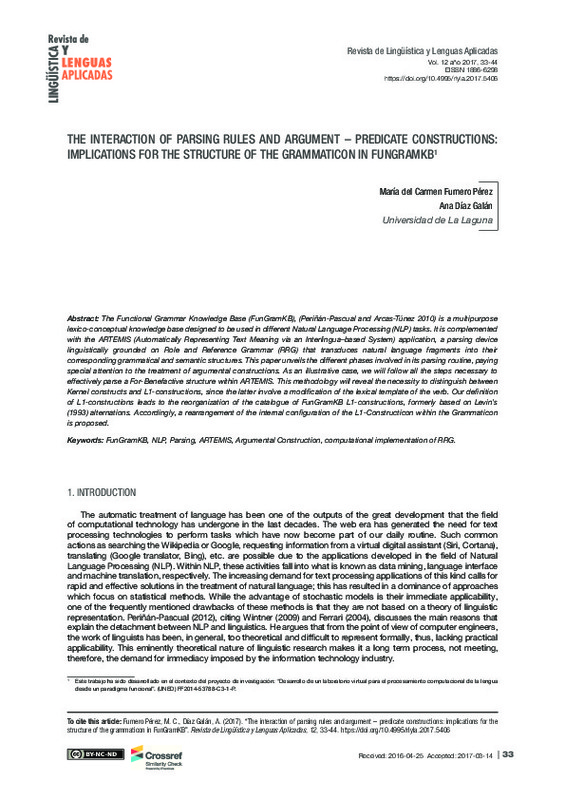Boas, H. and Sag, I. (2012). Sign-Based Construction Grammar. Stanford, Cal.: CSLI Publications.
Ferrari, G. (2004). State of the art in Computational Linguistics. Linguistics Today – Facing a Greater Challenge, 163. doi:10.1075/z.126.09fer
Goldberg, A. (1995). Constructions: A construction grammar approach to argument structure. Chicago: University of Chicago Press.
[+]
Boas, H. and Sag, I. (2012). Sign-Based Construction Grammar. Stanford, Cal.: CSLI Publications.
Ferrari, G. (2004). State of the art in Computational Linguistics. Linguistics Today – Facing a Greater Challenge, 163. doi:10.1075/z.126.09fer
Goldberg, A. (1995). Constructions: A construction grammar approach to argument structure. Chicago: University of Chicago Press.
Goldberg, A. (2006). Constructions at Work: the Nature of Generalization in Language. Oxford: Oxford University Press.
Levin, B. (1993). English Verb Classes and Alternations. A Preliminary Investigation. Chicago / London: University of Chicago Press.
Luzondo-Oyón, A., & Ruiz de Mendoza-Ibáñez, F. J. (2015). Argument structure constructions in a Natural Language Processing environment. Language Sciences, 48, 70-89. doi:10.1016/j.langsci.2015.01.001
Mairal Usón, R., & Ruiz de Mendoza Ibáñez, F. J. (2009). Levels of description and explanation in meaning construction. Deconstructing Constructions, 153-198. doi:10.1075/slcs.107.08lev
Peri-án-Pascual, C. (2012). "En defensa del Procesamiento del Lenguaje Natural Fundamentado en la Lingüística Teórica". ONOMÁZEIN, 26/2: 13-48.
Periñán-Pascual, C. (2013). Towards a model of constructional meaning for natural language understanding. Linking Constructions into Functional Linguistics, 205-230. doi:10.1075/slcs.145.08per
Peri-án-Pascual, C. and Arcas-Túnez, F. (2010). The Architecture of FungramKB. In Proceedings of the 7th International Conference on Language Resources and Evaluation, 2667-2674. Malta: European Language Resources Association.
Peri-án-Pascual, C. and Arcas-Túnez, F. (2014). The implementation of the CLS constructor in ARTEMIS. In Nolan, B. and Peri-án-Pascual, C. (eds.) Language Processing and Grammars the role of functionally oriented computational models. Amsterdam / Philadelphia: John Benjamins, 164-196.
Peri-án-Pascual, C. and Mairal Usón, R. (2010). "La gramática de COREL: un lenguaje de representación conceptual The COREL grammar: a conceptual representation language". ONOMÁZEIN, 21/1: 11-45.
Ruiz de Mendoza Ibáñez, F. J. (2013). Meaning construction, meaning interpretation and formal expression in the Lexical Constructional Model. Linking Constructions into Functional Linguistics, 231-270. doi:10.1075/slcs.145.09ib225
Ruiz de Mendoza Ibáñez, F. J., & Usón, R. M. (2008). Levels of description and constraining factors in meaning construction: an introduction to the Lexical Constructional Model. Folia Linguistica, 42(3-4). doi:10.1515/flin.2008.355
Sag, I, Wasow, T. and Bender, E. (2003). Syntactic Theory: Formal Introduction. Stanford: CSLI Publications.
Steels, L. (2015). "Introducing Fluid Construction Grammar". In L. Steels (ed.) Design Patterns in Fluid Construction Grammar. Amsterdam: John Benjamins, pp. 3-30.
Van Valin, R. D. J. (2005). Exploring the Syntax–Semantics Interface. doi:10.1017/cbo9780511610578
Van Valin, R. D., & LaPolla, R. J. (1997). Syntax. doi:10.1017/cbo9781139166799
Wintner, S. (2009). What Science Underlies Natural Language Engineering? Computational Linguistics, 35(4), 641-644. doi:10.1162/coli.2009.35.4.35409
[-]








